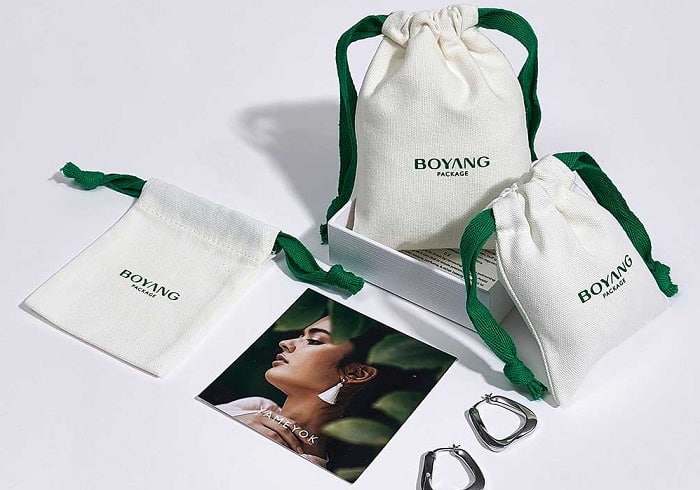You can share
- Share to Facebook
- Share to Google+
- Subscribe to our
- Share to Linkedin
- Share to Twitter

In the field of jewelry packaging, material selection directly affects product value delivery and user experience. When velvet and cotton, two mainstream materials, meet, how can practitioners accurately match brand positioning? How can consumers determine which one is more suitable for their needs?
(1) Touch and visual expression
Velvet jewelry bag:
Advantages: The short and dense fluff on the surface forms a unique luster, and the touch is as smooth as silk, with a "light luxury gene". Dark colors (such as dark green and wine red) can highlight the brilliance of jewelry and are often used in high-end wedding rings and diamond necklace packaging.
Case reference: Tiffany & Co.'s limited series uses customized velvet bags, and the LOGO uses hot silver technology, which instantly strengthens brand memory when the bag is opened.
Cotton jewelry bag:
Advantages: The natural cotton fiber has a simple texture, and the matte effect conveys a simple aesthetic. Suitable for silver jewelry or natural gemstone brands that focus on environmental protection and handcrafts.
Innovative application: Japanese brand "4℃" uses organic cotton bags with plant dye patterns printed on the bag body, echoing its "natural symbiosis" concept.
(2) Comparison of protective performance
|
Indicators |
Velvet cloth |
Cotton cloth |
|
Scratch resistance |
★★★★☆ |
★★★☆☆ |
|
Moisture resistance and oxidation resistance |
★★☆☆☆ |
★★★★☆ |
|
Fouling resistance |
★★☆☆☆ |
★★★☆☆ |
Conclusion:
Velvet cloth is more suitable for protecting high-hardness gemstones (such as diamonds and sapphires) and mirror-polished metals;
Cotton cloth has excellent air permeability and can delay the sulfidation and blackening of silver jewelry, making it suitable for long-term storage.
(3) Environmental protection and sustainability
Velvet cloth: Most of them are polyester-based. If recycled polyester (rPET) is used, the environmental rating can be improved, but the degradation cycle is still as long as 20-30 years.
Cotton cloth: Organic cotton and linen blended materials are completely biodegradable and meet the EU Ecocert certification standards, suitable for brands exported to the European and American markets.

(1) Comparison of unit cost (taking a 15×10cm standard bag as an example)
Due to the complex weaving process, the price of velvet cloth is generally 30%-50% higher, but the premium space is greater (customers are willing to pay 20% more for quality).
(2) Key points of supply chain management
Inventory risk: Velvet cloth is sensitive to dye batches, and there may be color differences between different batches. It is recommended that 10% of spare parts be reserved for the first order; cotton cloth has higher color fastness and strong storage stability.
Minimum order quantity: Velvet cloth MOQ usually starts at 500 pieces (customized colors require 1,000 pieces), and cotton cloth can accept small batch orders of 300 pieces.
(1) Reverse material selection from user scenarios
High-end gift scenarios (customer unit price> ¥5000):
82% of consumers think that velvet bags are "more ceremonial" and recommend matching them with magnetic buckle + ribbon design.
Daily repurchase scenarios (customer unit price ¥300-1000):
Since cotton bags can be reused as storage bags, 65% of users spread brand information for the second time (such as posting pictures on social media).
(2) Differences in regional market preferences
European and American markets: Emphasis on environmental certification, cotton bag search volume increased by 37% year-on-year (Google Trends data);
Asian market: Velvet search popularity continues to lead, especially during the wedding season when traffic soared by 200%.
To help practitioners make quick decisions, we refine key judgment dimensions:
(1) Brand positioning: Choose velvet for light luxury/high-end, and choose cotton for niche/environmental protection;
(2) Product characteristics: Cotton is preferred for easily oxidized accessories, and velvet is a must for easily scratched jewelry;
(3) Budget allocation: Cotton is recommended for initial market testing, and mature brands can upgrade to velvet to increase premium;
(4) User portrait: Generation Z prefers cotton, and customers over 35 years old recognize the value of velvet.
(1) Material mix and match design
Velvet + cotton and linen lining: The outer layer shows luxury, and the inner layer uses cotton cloth to enhance functionality. The cost increases by 15%, but the customer complaint rate decreases by 40%;
Removable double-sided bag: One side of velvet is used for gift giving, and the cotton cloth side is suitable for daily use after flipping.
(2) Technology upgrade direction
Functional coating: Velvet cloth adds a nano waterproof layer to solve the moisture-proof shortcoming;
Smart cotton cloth: Cotton cloth bag embedded with an NFC chip, users can view jewelry maintenance videos by touching their mobi
Choosing a velvet cloth or cotton cloth jewelry bag is essentially a precise balance between brand value and user needs. High-end lines can strengthen the "luxury gene" through velvet, while fast fashion jewelry brands use cotton cloth to convey environmental protection claims. It is recommended that practitioners regularly analyze sales data and user feedback and dynamically adjust packaging strategies.